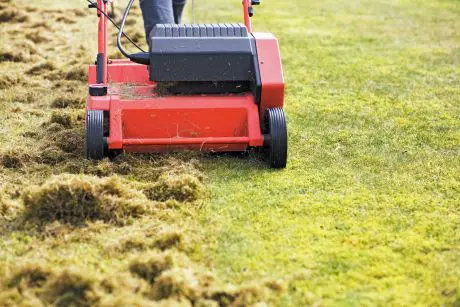
CommonCentsMom.com is advertiser-supported: we may earn compensation from the products and offers mentioned in this article. However, any expressed opinions are our own and aren't influenced by compensation. The contents of the CommonCentsMom.com website, such as text, graphics, images, and other material contained on this site (“Content”) are for informational purposes only. The Content is not intended to be a substitute for professional financial or legal advice. Always seek the advice of your Financial Advisor, CPA and Lawyer with any questions you may have regarding your situation. Never disregard professional advice or delay in seeking it because of something you have read on this website!
Can you use a power rake on dirt?
Some home builders and landscapers use it to level the area and prepare it for planting seeds; others use it to aerate lawns and sod. Power Rakes force dirt and other large materials like gravel and boulders down to allow them to lay easily. It can pound a huge amount of soil, rake big stones or rocky slopes, or even do a complete sweep over a large area.
One way that we can use it is to break up large areas of grass and other areas of a yard to create some space and to help keep things looking nice is to power rake over old soil. Even though our power rakes are very strong, they will not harm existing grass or trees. Use power rakers to assist you with cutting down trees, removing dirt, and topping up the grass on your property.
Can you power rake anytime?
Before the grass starts to turn green, winter or spring season are the best times to power rake most lawns. Early in the fall, power raking should be done on cool-season grasses like bluegrass. Outside of these times, power raking might harm your lawn by stripping away living turf from the growing season.
Aeration and dead matter removal are two great benefits of power raking. The waste is eliminated without harming the healthy grass because only the mulch layer is targeted, allowing for a quicker recovery. By removing this thatch layer, you can help your lawn breathe more easily and develop deeper roots.
Is power rake the same as Dethatcher?
A dethatch is essentially a small shovel designed to loosen up a layer of fallen limbs and trees up to 1/2-inches in thickness. Power rakes are powerful garden tools used by landscapers to lift and clear large amounts of loose and dead grass and other debris.
Dethatchers come with spring tines that rotate to move the thatch, and they also have power that allows them to be moved easily in and out of the garden. They have spring tines that are able to spin 360 degrees and loosen up to 1/2 inch of thatch.
When should I power rake my lawn?
If you have a good cut of tall grass that will not grow very tall, raking it with a power rake is usually done in the fall or spring. Grass that will remain healthy for a long time should be rowed in the summer. If you rake with a power rake, you are damaging the grass, and if you do not have a few weeks of good grass left, it will be difficult for the grass to grow back.
Soil shouldn’t be completely dry, but it shouldn’t be completely wet. If soil is too wet, it will cause the grass to grow a lot faster. Best power raking results occur when you work from two directions. Change the length of blades that slide beneath the rotomoulder so that it can contact and pull away the thatch that the rotomoulder is covering. Flails shouldn’t touch the soil. Clean up the fallen leaves quickly by using the kv or vacuum cleaner from Billy Goat or MV.

Should I cut grass before dethatching?
You should cut the grass of your lawn to around half its normal cutting grass height before dethatching. You can either rent detractors or hire someone to do it for you. Dethatchers, on the other hand, typically have multiple vertically aligned razors that can cut to the surface rather than a single horizontal cutter to cut grass. Additionally, they are very heavy, so it usually takes more than one individual to transport them.
You must set the depth and cutter spacing if you lease a dethatcher from a lawn service. To remove thatch and to scrape and stir the soil’s surface, the blades are frequently set to completely cut to half an inch into the surface (soil).
Is it better to power rake or aerate?
Power rakes and aerators are not an exact replacement for each of them, but they do provide many of the same benefits to lawns. Power rakes help you remove any accumulated loose dirt from your lawn. Aerating a lawn helps to uncompact the soil and promotes better grass growth.
If the thatch on your lawn is growing very tall, you might want to hire a power rake to remove it. Check for dead plants by taking a sample of the grass and soil on the outside of the house. Take a core sample of your soil and determine the amount of decaying plants that are under the surface.
The amount of decayed plant material should not exceed 12. It may be worth checking how much organic material is sitting on your lawn. It shouldn’t be more than 12. Examine the different areas of your lawn, as it can be difficult to see where your weeds are.
What do you do after you detach your lawn?
When you’ve removed everything you want to keep, you should mow your lawn. This helps to make sure that there is no more thatch growing under the surface of the grass. When you have finished mowing your yard, fertilizing it will encourage new grass to grow. Fertilize your yard to encourage more grass to grow.
Then, you must fertilize the area around the lawn that you are going to dethatch. Having a healthy lawn will help you to have a lush green lawn. When you water your grass regularly, it will grow well and will help you if it is really dry. You can detatch your lawn in a few easy steps and maintain the health of your grass.







